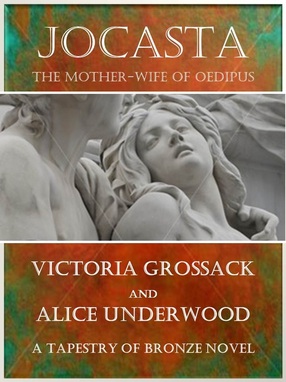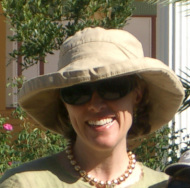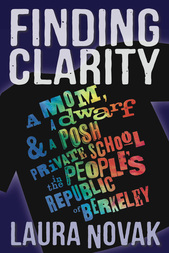
Victoria Grossack, a frequent commenter and the guest author of an early post called "Sarah Palin: Pregnancy and Probability," is co-author of the novel:
Jocasta: The Mother-Wife of Oedipus
And in light of these latest Palin photos we've found and the renewed discussion about the mythology surrounding a baby's birth and an infant's relationship to his mother, I thought this an ideal time to introduce Victoria to my readers.
LN: I Googled the topic “Sarah Palin and mythology” and do you know, Victoria, that more than 11 million hits came up in a second. There are many titles of articles out there using her name and that word together. What does this tell us?
VG: Today, the word “mythology” usually means a set stories that aren’t true, and if you got so many hits with that combination, obviously many people believe that the stories swirling around Palin are fake. But myths aren’t just false stories; they’re stories that are larger than life. One of the reasons that we're all so intrigued by this Palin "pregnancy" is the impact it’s had on us politically. But it's also so peculiar that it’s taken on mythic proportions – yet other bizarre family stories with major political significance have been around for millennia.
Three thousand years before Palin, there was another woman with a troubling pregnancy in her past and some scandalous secrets in the family. In Jocasta: The Mother-Wife of Oedipus, my co-author Alice Underwood and I revisit the myth of Oedipus, who accidentally married his mother. But we tell it from the point of view of Jocasta, because she was the one who had all the clues.
LN: A queen – a real one – potentially with dark secrets – who had all the clues! Just think about it: Palin is one of only a handful of people who know the real truth about so many things. Was she really pregnant? Was the ride really wild? Does Steve Schmidt know the truth? And with Jocasta you can ask: did she ever realize she was married to her son, and if so what did she do about it?
VG: Yes, they are both women with secrets - although we hope that your readers will like Jocasta more than they do Palin! Other characters in our book may be familiar to those following today's politics: a bumbling leader whose main strengths are his affability and good looks; destructive religious zealots; well-intentioned moderate believers; and some who simply use religion to justify what they do. We expect that human nature in the Bronze Age was very much like it is today.
LN: But they only had word of mouth and devious courtiers and servants or oracles to kiss and tell family secrets. Motivations might have been the same, but were secrets safer back then?
VG: I think most secrets were safer – and certainly those with power could preserve history as the way they liked it. The pictures on walls and temples were commissioned by those in power, and the bards, who like Homer sang histories aloud, had to please their patrons if they wanted to eat. So the media outlets of the time were controlled by those in power, and events were certainly spun to make them look better. But we all know these things are still happening today.
LN: There’s a great passage on page 251 where you write: “Melanthe dropped both palms towards the ground and thrust her chip upwards, breasts straining against her fine-pleated gown. The crowd hushed its applause once more as Melanthe fixed her kohl-rimmed stare on Polydorus. “Feed me,” she hissed at him, “and I live. Give me water, and I die.”
I understand she is posing riddles to the suitors here, but I dog-eared the page for a reason. It sent chills through me. Palin essentially thrust her chest out to the crowds and fixed her stare at the world and said, essentially, “feed me” but don’t question me. Does this resonate for you as well?
VG: We weren’t thinking of Palin when we wrote that scene, but you’re right! The powerful distract the crowds with whatever they can – sex and scandals, for example – so that the people don’t pay attention to what is really happening. While we’re watching Dancing With the Stars, or staring at Palin’s chest on the cover of Newsweek, the powerful are doing things they’d rather we didn’t notice. The Romans – about thirteen hundred years after our novels, but they borrowed much from the Greeks – even had a phrase for it: bread and circuses (the Latin is panem et circenses). It was a way of distracting the populace – keeping them from asking questions – so those in power could do as they pleased.
LN: Jocasta isn't your only research into the Bronze Age, or the only ancient political cover-up you've worked on.
VG: While writing Jocasta, we noticed a mass murder that has gone virtually unnoticed for three millennia. Those familiar with Greek mythology may remember Niobe, who allegedly cursed the mother of the gods Apollo and Artemis. The story goes that the twin gods took their revenge on Niobe by killing thirteen of her fourteen children. But if you don't accept supernatural explanations - and we think the idea that Apollo and Artemis actually killed people is even less likely than Palin's six-week pregnancy – then the question becomes, who did it?
LN: But we know from your book that Niobe became a blithering, insane old woman overnight. She could not bear the pain of losing her children. Palin seems to bear up under all manner of strain. I’ve often found that intriguing. I wonder if the commenters here will agree?
VG: Do you really think Palin has done so well emotionally? Although she obviously craves media attention, her ego is so fragile that her keepers protect her from the simplest questions. And when she misspeaks, instead of saying, “That was a mistake; of course Paul Revere was riding to warn the colonialists and not the British,” her supporters try to change reality – or at least the history recording it. I think Palin’s skin is becoming thinner and even more stretched with time – even less substance and more air. She reminds me of an inflatable doll.
But back to Niobe and her children. One of the amazing things is that, as far as we can tell, no one has even asked who murdered Niobe's children. The murderer threw the veil of religion over his deed, making it heretical even to question the murders. Others were probably bribed to stay silent – or were too afraid to speak out. And over time the deaths at the hands of the gods became accepted simply as truth – and then as myth. However, if you look at other stories associated with some of Niobe's contemporaries – her father, her brothers and her husband – suspects emerge.
LN: I’m sorry, I just had the strangest feeling: remind me, are you talking about a queen of Thebes or Sarah of Wasilla? The themes are frighteningly similar and overlapping. “No one asked the critical question” and “over time the story became the truth.”
VG: These legends show that some problems have been a part of the human condition for a long time. And every generation has to fight the fight anew, because every generation contains people who seek to hide the truth. Sometimes the truth-hiders win, for the complacent are easily misled – but sometimes they don’t, because a few brave men and women struggle to get out the facts. Right now the battle is up to people like you, Laura!
LN: Well, that’s a weight off my shoulders! One of the things that struck me while reading Jocasta is not only how well it’s written – the language is beautiful and your research went quite deep. You’ve got every detail nailed down. There’s not a sloppy or slapdash moment in the entire story. Have you written other books set in this era?
VG: Yes, Alice and I wrote a trilogy that covers the whole rich story leading up to the murders. The books are: Children of Tantalus, The Road to Thebes and Arrows of Artemis. Our readers have found them engrossing, real page-turners, but they also show that politicians have been using manipulative techniques for a long time. You don't need to know Greek mythology to enjoy them – though if you are familiar with some of the myths that adds a bit of extra fun. We think anyone who likes fiction, who needs a break from the stresses of the day or Palin politics, will find they offer a fabulous escape. And they’re must-haves for those who like Greek mythology.
LN: For more information and to see the reactions of some reviewers, check out A Tapestry of Bronze.
Here are some great blurbs to get you started:
The most amazing part of the series is how the authors retell the myths in such a way as to work for modern audiences.... definitely worth reading by fans of fiction and Greek mythology.
--NS Gill, About.com, Ancient History
A fresh discovery for this reader. A world...as compelling as Tolkien's but more rooted in actual history...in the spirit of Graves's I, Claudius.
–Bob Mielke, Professor of English, Truman State University, in The Copperfield Review, Summer 2011
Grossack and Underwood have an unfailing ear for dialogue and drama. The resulting books will draw inevitable comparisons to the work of both Robert Graves and Mary Renault, but throughout these books … Grossack and Underwood consistently manage a wit and breadth all their own. Readers will find themselves flying through these volumes, gripped the whole time. Very strongly recommended.
--Steve Donoghue, Historical Novels Review Online, August, 2011.
Thank you, Victoria Grossack, and Alice Underwood, for taking the time to discuss your work with us here. Victoria will check comments, so please join the conversation!

 RSS Feed
RSS Feed



